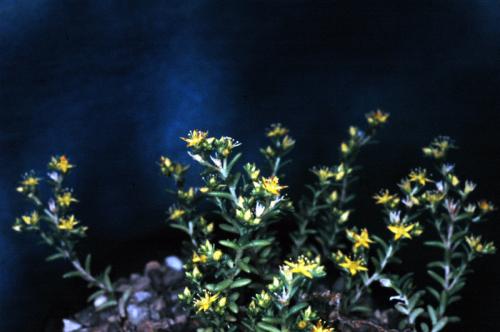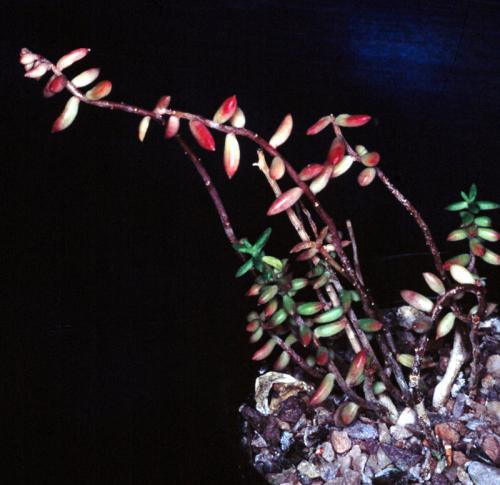PARVUM Hemsley, 1878
Synonyms :
Altamiranoa parva (Hemsley) Rose (1903) / Villadia parva (Hemsley) H. Jacobsen (1958)
Distribution : Mexico (San Luis Potosí) ; rock outcrops or ledges, 2000 - 2700 m.
Description (according to IHSP, 2003) :
Small perennial tufted herbs from creeping rhizomes, much branched, 3 - 5 cm tall, stems green, smooth, with a reddish sheen below.
Leaves evenly sized and spaced, alternate, oblong and very flat, obtuse, shortly spurred, mamillate towards the tip, 4 - 8 x 2 - 4 mm, suberect, green.
Inflorescences : Flowering branches erect, stout, inflorescences few-flowered cymes, bracts lanceolate, obtuse.
FIowers 5-merous, subsessile, sepals broadly sessile, unequal, lanceolate, obtuse, mamillate at the tip, ± 2,5 mm, petals nearly free to the base, lanceolate, obtuse, narrowly mucronate, erect, 4 - 5 mm, yellow.
Cytology: 2n = 64, 68, ± 120, 128
Ray Stephenson (Sedum, Cultivated Stonecrops, 1994, pp 259 - 260) :
A diminutive species, rare in cultivation, Sedum parvum resembles S. moranense except it has yellow flowers. Papillose leaves are short and crowded on wiry stems that are bare in the lower half. Plants become untidy with age. Flowers of late summer are produced singly.
Habitat : This species is native to mountains of southwest San Luis Potosí.
Main points of distinction : Tiny, spurred leaves are more patent than those of Sedum moranense, and the plant is much less tidy in appearance. Together, the 5-cm (2-in) long stems with the leaves are very narrow. Blunt, papillose sepals are not spurred, but are united for one-quarter their length. Mucronate petals are just united, and nectaries are spathulate. Sedum nanifolium is very closely related and regarded by Clausen to be a subspecies of S. parvum. Although the latter has a very similar habit of growth, leaves of S. nanifolium are longer and more patent.
Variation : Sedum parvum ssp. diminutum (Hemsley) Clausen is, as the name suggests, an even more feeble form [in the meantime (1996) Nesom has published S. diminutum as a species]. It has a chromosome count of n = 34. Sedum parvum has n = 32, 32 + 2B, circa 60, and 64 (Uhl 1985).
Horticulture : This stonecrop is interesting to the specialist, but of little horticultural use.

